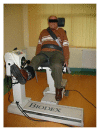The Effects of Aquatic Exercises on Physical Fitness and Muscle Function in Dialysis Patients
- PMID: 26161421
- PMCID: PMC4487931
- DOI: 10.1155/2015/912980
The Effects of Aquatic Exercises on Physical Fitness and Muscle Function in Dialysis Patients
Abstract
Purpose: The aim of this study was to assess the impact of a 3-month physical training program, conducted in an aquatic environment with end-stage renal disease patients (ESRD), on the physical fitness and functional parameters of the knee joint muscles.
Patients and methods: The study included 20 ESDR patients with mean age 64.2 ± 13.1 y. treated with hemodialysis in Dialysis Center of the University Hospital in Wroclaw. Before and 3 months after the physical training in water, a test was performed to evaluate the physical fitness of each patient; additionally, a measurement was taken of force-velocity parameters. The 3-month training program took place on nonhemodialysis days, in the recreational pool of the University of Physical Education in Wroclaw.
Results: After aquatic training cycle, an improvement was observed in all parameters measured using the Fullerton test. The value of peak torque and its relation to body mass increased in the movement of flexors and extensors of left and right lower extremities in all tested velocities.
Conclusions: In assessing the physical fitness of studied women, the biggest improvement was achieved in tests assessing the strength of upper and lower extremities as well as lower body flexibility. Higher values of force-velocity parameters are conducive to women achieving better physical fitness test results.
Figures
References
-
- Johansen K. L., Doyle J., Sakkas G. K., Kent-Braun J. A. Neural and metabolic mechanisms of excessive muscle fatigue in maintenance hemodialysis patients. American Journal of Physiology: Regulatory Integrative and Comparative Physiology. 2005;289(3):R805–R813. doi: 10.1152/ajpregu.00187.2005. - DOI - PubMed
-
- McIntyre C. W., Selby N. M., Sigrist M., Pearce L. E., Mercer T. H., Naish P. F. Patients receiving maintenance dialysis have more severe functionally significant skeletal muscle wasting than patients with dialysis-independent chronic kidney disease. Nephrology Dialysis Transplantation. 2006;21(8):2210–2216. doi: 10.1093/ndt/gfl064. - DOI - PubMed
-
- Chojak-Fijałka K., Smoleński O., Miłkowski A., Piotrowski W. The effects of 6-months physical training during hemodialysis in ESRD patients. Rehabilitacja Medyczna. 2006;10(2):25–36.
MeSH terms
LinkOut - more resources
Full Text Sources
Other Literature Sources
Medical


